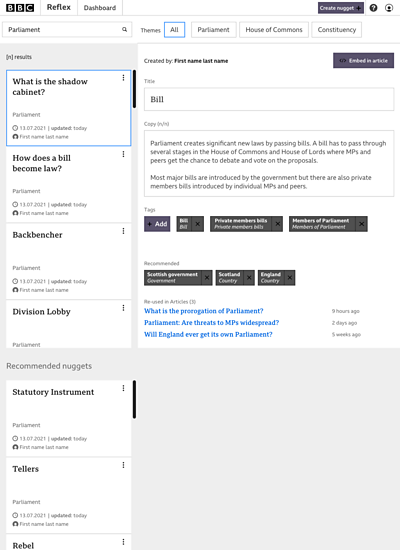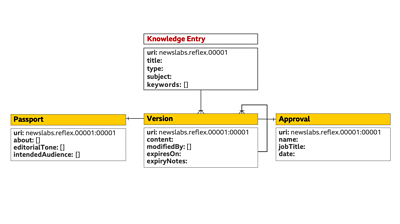Aims
Making it easier to reuse and discover knowledge across BBC News.
Outline
This project aims to improve audience understanding by providing the right explanation for each audience member at the right time, whilst making it a lot more efficient for journalists to include these pieces of background context in stories by breaking them down into reusable blocks.
Most news stories lead on what is new or extraordinary before hopefully, but not always, adding some background context or explanation for the audience.

With our mandate to serve all audiences the problem of making our stories understandable is a big one for the BBC. Don’t explain enough and we lose the reader, explain too much and it feels patronising.
This project builds on our learnings from the Explainer Builder prototype which news teams used to improve audience understanding on the biggest stories in 2020 including the coronavirus pandemic and its economic fallout, climate change and the US election.
Structured authoring
The Explainer Builder allowed journalists to create question and answer pairs on their chosen topic for easy reusability, and embedded these on news pages. The embed included a search function for audiences to type in questions and hopefully get back relevant answers.
This new iteration takes a different approach to the creation of content. We've tasked journalists with writing very short, one or two sentence, definitions which are reusable.
We know that journalists already do this when writing about complicated topics — for example, a journalist writing about blockchain technology might search the web to find another BBC story on the topic and copy or tweak its explanation (a "digital ledger" or "distributed ledger"). Or, an article on the economy might re-use a block of content from an Explainer article that explains what inflation is.
By storing these different definitions, we can eventually render what we think is the most appropriate level of detail for each audience member to understand a story.
That project allowed journalists to create question and answer pairs on their chosen topic, and embedded these on news pages, outside of the body of their stories. It included a search function for audiences to type in questions and hopefully get back relevant answers on the topic of the story.
This new iteration takes a different approach to the creation of content. We've tasked journalists with writing very short, one or two sentence, definitions which are reusable. These definitions can then be stacked to create hierarchies that read as coherent explanations for audiences.
An example is the definition of the second reading from our political research unit, which references the explanation of a bill, to ultimately create a block that helps audiences understand how the house of commons creates laws.
Designing for personalised discovery
So far we've designed how we think this system would work in the newsroom, including the user interfaces for maintaining knowledge blocks, which could potentially integrate with the content management system where journalists write their stories.
We've built a working prototype of the backend API that enables the creation and discovery of these blocks and started to populate it with the draft content from our brave pilot team in Westminster.

The data schema allows for the creation of multiple versions of a knowledge entry (be it a definition, bio or explanation) to serve different audience segments appropriately. These versions are then tracked and easily discovered using the BBC's content metadata passport system.
Next steps
We are looking at continuing this experiment by creating content in a semi-automated way using natural language processing to extract valuable nuggets from existing articles for reuse elsewhere, with sub editing from journalists included in this loop.
This prototype will hopefully enable other teams, including a new expertise, breadth and depth product team, to experiment on new ways to render these explanations to audiences to meet the ultimate goal of personalised understanding of the news.
Tweet us @BBC_News_Labs if you want to find out more.
Results
- News teams are creating content specifically for the prototype and experimenting with assembling and discovering blocks of knowledge in this system.
Team
Similar projects
View all "new audience experiences" projectsBBC News Labs
-

News
Insights into our latest projects and ways of working -

Projects
We explore how new tools and formats affect how news is found and reported -

About
About BBC News Labs and how you can get involved -

Follow us on X
Formerly known as Twitter







